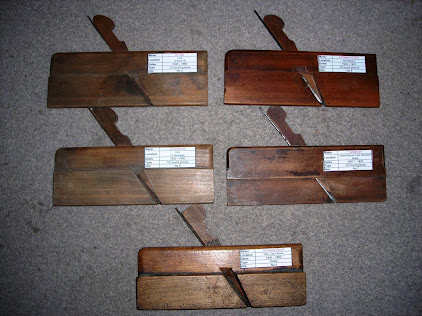adzeman
Established Member
The best present bought for me this year was by my number one son. The book, "British Plane Makers from 1700", a very informative book. Spending some time in my native Yorkshire since Christmas took this as an opportunity to add some locally made planes to my collection. Searching the antique shops of Skipton I made enquiries to with the shopkeeper if she had any wood planes for sale. No was the response but she knows a man who brought a box of planes in for sale recently to which she had no interest but would give him a ring.
First, I found one I believed originated from Leeds but on checking Goodman could be Liverpool circa 1817-1822 marked, ? Anderson.
Second, one marked Preston & Son. I know Prestons were based in Birmingham circa 1904-1931 but, when as an apprentice we paid a shilling into a club taken direct from our pay recorded on a card and a salesman from Prestons would call and sell us quality tools in an age of rationing scarcity. I would be interested to find out if this is the same Preston’s and if any other people were in their tool club.
Third, a plane made by G Eastwood of York which had no marks from its owner and was calling out to be loved.
Fourth plane was stamped Summers Varvill Ebor Works York, a maker mentioned in Goodman within the text. The name stuck in my grey matter. What drew my attention was the stamp was in copper plate script and again Goodman makes this reference.
Fifth plane, the maker being W Dibb of York looked promising for research as it was stamped the Earl of Strathmore the father of the late Queen Mother. Stately homes keep good accounts so there should be documented evidence when they purchased it from W Dibb. I was sidetracked when I discovered that an Earl of Strathmore purchased and still owns, a large ironmongers in , and it could have been bought as stock for this establishment. This proved to be a red herring. This plane had only one owner a Mr Bowes which is the family name of the Earls of Strathmore, (Bowes Lyon). So this should be researchable and how did this plane get down to Skipton?

The present snowy weather gives me the opportunity to fettle them up for use.
First, I found one I believed originated from Leeds but on checking Goodman could be Liverpool circa 1817-1822 marked, ? Anderson.
Second, one marked Preston & Son. I know Prestons were based in Birmingham circa 1904-1931 but, when as an apprentice we paid a shilling into a club taken direct from our pay recorded on a card and a salesman from Prestons would call and sell us quality tools in an age of rationing scarcity. I would be interested to find out if this is the same Preston’s and if any other people were in their tool club.
Third, a plane made by G Eastwood of York which had no marks from its owner and was calling out to be loved.
Fourth plane was stamped Summers Varvill Ebor Works York, a maker mentioned in Goodman within the text. The name stuck in my grey matter. What drew my attention was the stamp was in copper plate script and again Goodman makes this reference.
Fifth plane, the maker being W Dibb of York looked promising for research as it was stamped the Earl of Strathmore the father of the late Queen Mother. Stately homes keep good accounts so there should be documented evidence when they purchased it from W Dibb. I was sidetracked when I discovered that an Earl of Strathmore purchased and still owns, a large ironmongers in , and it could have been bought as stock for this establishment. This proved to be a red herring. This plane had only one owner a Mr Bowes which is the family name of the Earls of Strathmore, (Bowes Lyon). So this should be researchable and how did this plane get down to Skipton?

The present snowy weather gives me the opportunity to fettle them up for use.





































